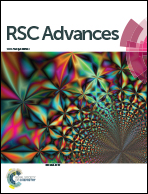Copper-catalyzed stereo- and regioselective hydrophosphorylation of terminal alkynes: scope and mechanistic study†
Abstract
Herein, a protocol for copper-catalyzed highly stereo- and regioselective hydrophosphorylation of terminal alkynes to E-alkenylphosphorus compounds was well developed. It represents a general and practical hydrophosphorylation method, of which diarylphosphine oxide, dialkylphosphine oxide and dialkyl phosphite all had effective P(O)H parts to react with different types of terminal alkynes. Contrary to previous air-sensitive reports, all the reactions proceeded well under air. This methodology is quite attractive owing to the high stereo- and regioselectivity, good functional group tolerance, scalability and facile late-stage derivatization of some natural product derivatives and commercially available herbicides. What's more, investigations on the reaction mechanism with deuterium-labeling experiments and DFT studies firstly disclosed the deprotonation–protonation equilibrium of terminal alkynes and P(O)H part during the catalytic hydrophosphorylation process.



 Please wait while we load your content...
Please wait while we load your content...